
Features
Operations
The assault from above
Wildfires – unplanned or unwanted, natural or human-caused fires – are a fact of life in Canada. With more than 400 million hectares, or about 10 per cent of the earth’s forests, Canada has averaged some 8,600 fires annually over the past 40 years.
May 9, 2012 By Paul Dixon
Wildfires – unplanned or unwanted, natural or human-caused fires – are a fact of life in Canada. With more than 400 million hectares, or about 10 per cent of the earth’s forests, Canada has averaged some 8,600 fires annually over the past 40 years. While only three per cent of these fires grow to more than 200 hectares, they account for 97 per cent of the area burned across the country. Total area burned varies greatly from one year to the next, but the 30-year average is 2.6 million hectares annually, from a low of 0.3 million hectares in 1978 to a high of 7.5 million hectares in 1989.
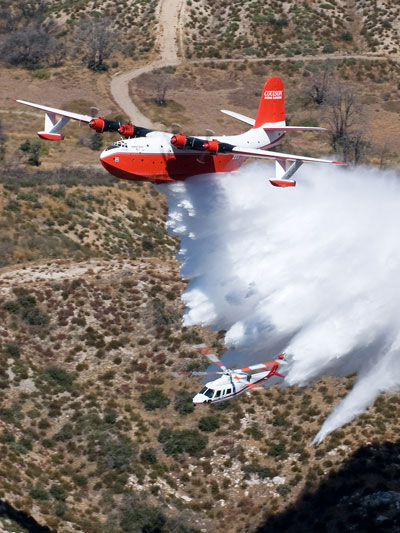 |
|
| Coulson Air Tankers of Port Alberni, B.C., is best known as the operator of the iconic Martin Mars flying boats, mainstays of aerial firefighting in B.C. for almost 50 years. Photo: Coulson
|
Directly and indirectly, forestry-related industries employee hundreds of thousands of Canadians and provide tens of billions of dollars to the national economy. Once dominated by pulp mills supplying the world’s newspapers and sawmills producing dimension lumber, Canada’s forest industry is reinventing itself to meet the needs of a changing world economy.
Over the past century, Canada has developed some of the most sophisticated forest management and wildland fire management systems in the world to minimize the occurrence of wildfire and contain it when it does occur. From an attitude in the beginning that “all fire is bad,” a realization developed that fire has an essential role in maintaining a healthy ecosystem. This led to the development of management systems that took a number of factors into consideration for fighting wildfires, including the ecology, the cost of suppression and prioritizing values and risk.
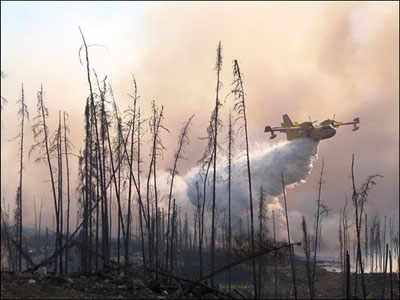 |
|
| Ontario owns its own fleet of CL-415 aircraft and they are flown and maintained by provincial employees. Photo: MNR
|
The Canadian model of operations has not been built in isolation from the rest of the world, but rather is based on the experience of others and often in collaboration with agencies in other countries. As we have seen in the past, there are valuable lessons to be learned from what is happening today in other countries, environmentally, economically and politically.
In 2005, the Canadian Council of Forest Ministers released the Canadian Wildland Fire Strategy, addressing critical issues identified in the wake of the disastrous 2003 fire season, which saw hundreds of homes destroyed and tens of thousands of people evacuated in Western Canada. In 2010, an update to the original report cited information from fire seasons in every region of the country that had reached epic proportions in the preceding five years.
The Central Westcoast Forest Society states unequivocally, “Climate change will have significant impacts on Canada’s forests. The Canadian Forest Service has used General Circulation Model projections for the 21st century in its forest fire models to estimate that by 2040, Canada will be experiencing significantly increased fire occurrence and fire spread potential, based on climate change impacts on temperature and precipitation patterns. In 2006, Ontario used these estimates within its level of protection analysis system to gauge the impacts of this increased fire activity on Ontario’s suppression capabilities and success in containing wildfires. It was predicted that in order for Ontario to maintain its current level of fire response success in this projected more severe fire regime, it would need to double its fire suppression resources.”
Dr. John Pomeroy, head of the University of Saskatchewan’s hydrology department, stated in a recently released report that it will only take a four-degree change in temperature to cause dramatic changes to the snow levels across much of Canada’s prairies and mountains. He is one of a group of Canadian scientists who state bluntly that our winter season has been diminishing steadily over the past several decades as evidenced by the fact that the ice cover on our lakes and rivers has shortened by two weeks in that time.
A world on fire
Scanning the globe, we get a hint of what the future may look like. Australia is still reeling from its disastrous fire season of 2009. Greece, Italy, Spain and Portugal have had massive fires in recent years.
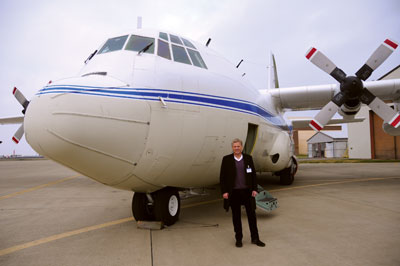 |
|
| Wayne Coulson shows off his latest acquisition: an EC-130Q that Coulson will be converting into an air tanker. Photo: Paul Dixon
|
The U.S. seems to suffer from a growing series of catastrophic wildfires and interface fires every year as temperatures steadily rise, humidity drops and the winds continue to blow. In a note of respite, officials in West Texas declared a lessened fire danger this year, not because of favourable weather, but because a continued extreme drought means that vegetation destroyed in previous years was unable to regenerate. The fire danger decreases because there is nothing left to burn.
The American situation has been exacerbated by the decimation of the fleet of large air tankers over the past decade. The U.S. Forest Service is the lead agency in certifying aircraft for firefighting duties (apart from Federal Aviation Administration certification of airworthiness), acting for all federal agencies that have firefighting responsibilities, such as the Bureau of Land Management and the U.S. Park Service. Ten years ago, there were 44 aircraft certified as Large Air Tankers within the U.S., then two spectacular crashes of ex-military air tankers on active fire sites resulted in more than 20 of the fleet being permanently grounded.
In June 2011, eight P-3 Orion aircraft operated by Aero Union of Sacramento, Calif., had their certification revoked by the US Forest Service (USFS) over a question of inspection practices. The result is that 2012 dawned in the U.S. with only 11 large air tankers on its roster, 10 P2-V aircraft – ex-military aircraft more than 60 years old – and a new addition to the aerial firefighting world, a BAE-146 operated by Neptune of Montana. A second operator, Minden Air Corp of Nevada, is currently converting two BAE-146 aircraft to aerial tankers.
Fixed-wing aerial firefighting planes are divided into two categories – waterbombers and aerial tankers.
Waterbombers include the Canadair/Bombardier 215 and 415 amphibians, while fixed-wing wheeled aircraft constitute the tanker community. Tankers are broken down further based on the size of payload the aircraft is capable of delivering: Light (less than 4,000 litres); Medium (less than 12,000 litres); and Large (12,000 litres and above). The Evergreen 747 tanker (78,000 litres), Tanker 10 DC-10 (45,000 litres) and Coulson Martin Mars (27,600 litres) are classed as Very Large Air Tankers.
Joining forces
Although the regulatory environment and operational models differ between Canada and the U.S., it has been a long-standing practice to align Canadian practices with USFS standards. To that end, Canadian operators of large air tankers are facing the same challenge as their American counterparts. Air Spray of Edmonton, Conair of Abbotsford, B.C., and Buffalo Airways of Yellowknife operate Canada’s principal fixed-wing tanker fleets with the Lockheed L-188 Electra (civilian cousin of the P-3 Orion/CP-140 Aurora) as the plane of choice. There were only 170 Electras ever built, the last in 1961, and their best-before date is rapidly approaching.
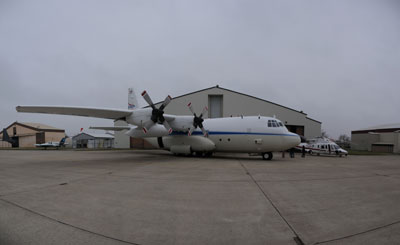 |
|
| Coulson will add a 5,000 U.S. gallon Retardant Aerial Delivery System (RADS) to its converted EC-130Q. Photo: Paul Dixon
|
The Canadian aerial firefighting environment is a mixture of Company-Owned Company-Operated (COCO) aircraft, Government-Owned Company-Operated (GOCO) and Government-Owned Government-Operated (GOGO). British Columbia is entirely COCO, with all aircraft – fixed-wing and rotary – hired on seasonal lease. Alberta owns its fleet of CL-215T amphibians, but contracts Conair to staff and operate the aircraft.
Ontario owns its own fleet of CL-415 aircraft and they are flown and maintained by provincial employees. At times where needs dictate, private operators will be hired on a call-when-needed basis or resources will be allocated from one province or territory to another through the Canadian Interagency Fire Fighting Centre (CIFFC).
The use of firefighting aircraft varies across the country, and is largely dependent on geography and terrain. The 215/415 amphibians are popular nationwide, with the exception of B.C. The smaller fixed-wing tankers such the Air Tractor 802 are popular with the government of New Brunswick, whereas Conair runs a fleet of amphibious 802s that are dispatched across Western Canada during the season. Large air tankers as operated by Air Spray, Conair and Buffalo, are seen in B.C., Alberta, the Yukon and the Northwest Territories.
The 215/415 scoops water, which may be injected with gel before dropping, whereas the tankers generally are loaded with retardant. The water/gel loads can be dropped on a fire for a cooling effect to allow ground personnel to work in close, while retardant is used to build containment lines to block fires or deflect their advance. There are different aircraft with different loads for different purposes. For example, Ontario rarely utilizes retardant carrying aircraft, but according to Tom Ball, aerial operations co-ordinator with MNR’s aviation, forest fire and emergency services branch, due to an exceptional fire season last year, 29 aircraft (CL-215s, CL-215Ts, CL-415s) were brought in from outside the province through CIFFC. They dropped 105 million litres of water in addition to the work of Ontario’s own aircraft.
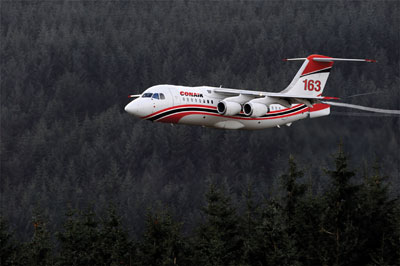 |
|
| The RJ-85 is a more modern version of the BAE-146 and has different engines, numbers, weights, and performance, says Conair’s Rick Pedersen. Photo: Conair
|
The challenge for private operators of large air tankers in Canada is finding aircraft to replace their current aging aircraft that are as economical to acquire as they are to operate. Rick Pedersen, senior vice-president of Conair, discussed with Wings the company’s project of converting an RJ-85 regional jet, a later version of the BAE-46, as an air tanker.
“It’s certainly a big program for us, we’ve been working at it for three-plus years now and it’s well underway,” he says. “It’s targeted to be online for the 2013 fire season. We purposely picked the RJ-85 as it’s a more modern version of the BAE-146 and it has different engines, different numbers, weights, and performance. The platform met our criteria and we’re working closely with British Aerospace on the engineering and evaluation side – the program is well on its way.”
Pedersen says Conair’s thought process was simple: “Typically, we put a 20- to 25-year window on an aircraft we convert. When we started with the Convair 580 group in 2000, we decided it was an aircraft that could be operated and supported efficiently for 20 years. We’re now into that second 10-year period, so we’re starting to gear up to have a replacement. When they start to retire, we’ll be in position to go with a replacement. With the Electra, we feel there’s still good life in them and the OEM supports them, but I think it’s only prudent that we find a good replacement for them.”
Conair’s sister company, Cascade Aerospace, converted two Bombardier Q-400 aircraft for the government of France seven years ago and Conair has operated the aircraft from a base in Marseille ever since.
Pedersen says of the Q-400: “It’s got a great track record. The planes travel around the world doing different missions, whether it’s firefighting or humanitarian support the French government takes on. I think it will find a way eventually into North America. The aircraft lends itself to higher utilization. When we put that aircraft together for the customer, they wanted a multi-mission aircraft and certainly on the certification side, it’s unique in that its the only one out there that we’re aware of that can be an air tanker and be converted to a transport or passenger category – 64 passengers or 10 metric tonnes.”
The RJ-85 will have a 12,000-litre capacity, while the Q-400 can carry as much as 10,000 litres of retardant. The ability to use an aircraft such as the Q-400 for a variety of missions on a year-round basis speaks to the economic pressure on companies with large aircraft that have limited use outside of fire season.
Going another route
Another Canadian operator has a slightly different approach. Coulson Air Tankers of Port Alberni, B.C., is best known as the operator of the iconic Martin Mars flying boats, mainstays of aerial firefighting in B.C. for almost 50 years. Acquired from its original owners in 2007, Coulson has updated the Hawaii Mars with a glass cockpit and an IT system that allows it to interface with Coulson’s S-76B Firehawk, flying as lead plane for the Mars, selecting targets and pinpointing them with IR and GPS, recording drops with video and streaming information back to the Mars and to fire management personnel on the ground in real time.
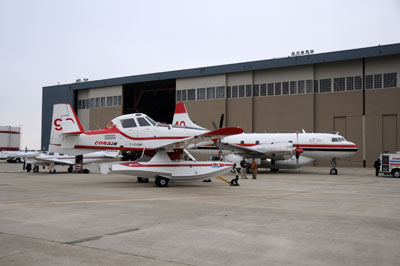 |
|
| “Typically, we put a 20- to 25-year window on an aircraft we convert,” says Rick Pedersen, senior vice-president of Conair. Photo: Paul Dixon.
|
Building on the reputation Coulson’s S-61 helicopters had established fighting fires in the U.S. and with a support system that would make a NASCAR team envious, the Mars moved into the U.S. for contract work with USFS and the state of California. With a crew bus, tractor-trailer workshop rig and its own fuel truck, the Mars can operate just about anywhere there is a body of water it can land on. In 2011, the Mars team worked on a series of fires in northern Mexico and later in the year worked in northern Alberta.
Coulson’s current project is converting an EC-130Q into an air tanker by adding a 5,000 U.S. gallon Retardant Aerial Delivery System (RADS). Like the 3,000 U.S. gallon Mobile Aerial Fire Fighting (MAFF) system used in U.S. National Guard C-130s, the RADS system is modular and can be easily removed, allowing the aircraft to revert to being a cargo carrier. The RADS system in Coulson’s aircraft will carry a larger payload because it is a gravity system, with no need for machinery and compressors and the special operator the MAFF requires. The result, Wayne Coulson says, “will be the second largest propeller driven firefighting aircraft in the world after the Mars.” The key for Coulson’s development of the new tanker is utilizing the same technology currently used in the Mars to maximize the results.
Looking to the future, Coulson and Pedersen are on the same track when it comes to the systems their companies are developing for the next generation of aerial firefighting. Says Pedersen: “Our approach is for every jurisdiction we go to, to meet the customer’s requirements.” Coulson agrees, adding, “What I am keenly interested in doing is measuring our business and creating the best value for our customers.”
Providing value for customers while employing advanced aerial firefighting systems that can deploy plenty of water and retardant from large-scale, fixed-wing aircraft – it’s an excellent blueprint to effectively deal with Canada’s expanding wildfire management needs.